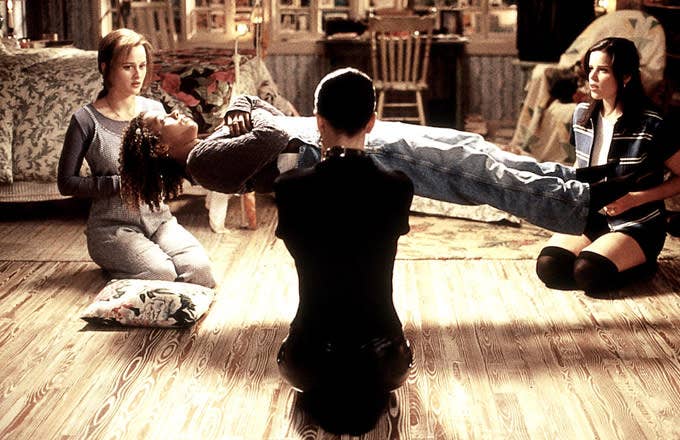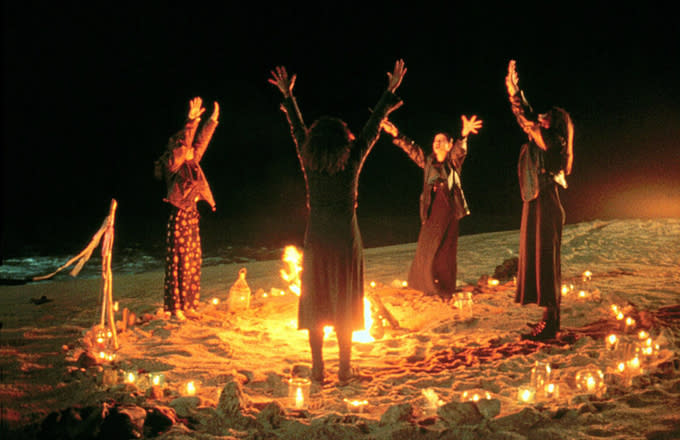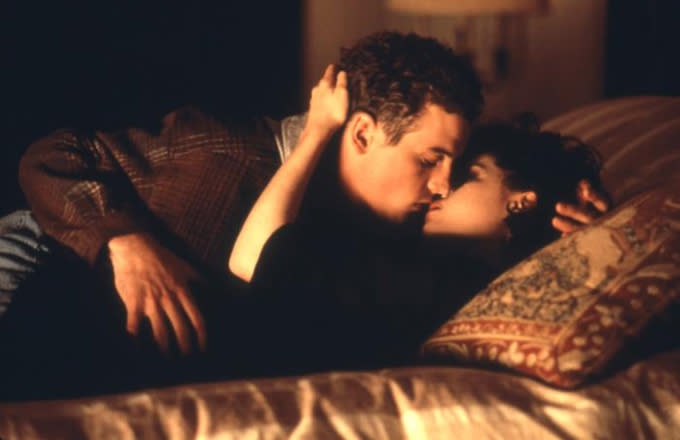
Watching The Craft is a rite of passage for young women. Released in 1996 and starring a pre-Scream Neve Campbell, a post-Empire Records Robin Tunney, Fairuza Balk, and Rachel True, this story about four high school girls with witchy powers became canon in teen cult horror, '90s fashion goals, and female empowerment. "The rise of the witches' power parallels teenage sexuality. There's something about their powers that mirrors what a teenager goes through," True (who played Rochelle) tells me over the phone, pondering what makes something a "cult classic." Certainly there's something about it that resonates even 20 years later, and why it's still a must-see coming-of-age film.
Even though it was released 20 years ago, The Craft feels much more progressive than many of the movies that come out today. There's diversity in the main cast, and racism was even an issue that was openly addressed in the movie, through Rochelle, a black character who is bullied by her white classmate, Laura (Christine Taylor). The film shed light on this kind of discrimination, and opened doors for conversations on the topic to be had more openly. (Though, as True points out, The Craft's portrayal of a black teen was still pretty thin: "Nancy is dealing with poverty and an abusive home, Bonnie has burns, Sarah has a suicidal past, and me, I’m just black. I’m still the black best friend. It’s still that trope to a certain extent, even in The Craft.")
The Craft is also an important film for young, impressionable women because it taught them that you can be your weirdo, outcast self, as long as you are kind to yourself and others. You don't need to take off your glasses and overalls or change your outer appearance in any manner; you don't even need approval from boys. You just need to check your inner harmony (karma is a huge part of the narrative as well). The Craft made me proud to be an "outsider"; it made me want to embrace the things that made me different from the rest of the flock.
As The Craft celebrates its 20th anniversary on May 3, director Andrew Fleming, writer Peter Filardi, and actress Rachel True tell us how four of the film's most famous scenes came together. Read below to find out about the technical challenges, spooky behind-the-scene mishaps, and original story drafts that led to the cult favorite that is The Craft.
Light As a Feather, Stiff As a Board

Andrew Fleming: I had an older sister and she and her friends played that game in front of me and it stuck in my head. And I’d never seen it in a movie or heard everyone talking about it, and I brought it up in a meeting before I actually wrote that.
Peter Filardi: I didn’t write that scene, but it’s much more cinematic than playing Ouija Board or something else. I think the mother’s line, “Are you girls getting high in there?” is hilarious.
Andrew Fleming: Well, this was in the Plasticine era of digital video effects, and it would be a lot easier to do now, but we basically built the set around this one shot. It was raised, and there was a pole that came up from the floor underneath Rachel and this form-fitting metal pan that was the shape of her back and legs. The clothes were put on over that. Just to add difficulty to it I wanted the camera move, so the camera was on a computerized arm.
Rachel True: Back then technology was very different. We had to do green screens and play shots. That was on a hydraulic lift. You’d have to shoot the set with no one in it, completely still. Then you’d shoot us in it. It was very tedious. I could see how, as a director, it could maybe be not so fun, but for us it was totally fun. We were just hanging out in our chairs gossiping until they were ready with all of their fancy technology. I remember I had to wear some kind of back brace underneath my overalls that the hydraulic thing fit in. There was so much wire I was like, “This is making my hips look ginormous."
Andrew Fleming: When she fell, it was a certain kind of cutting. We dropped her down really quick and then in another shot she reacted. It was a complicated shot for the time, but something we could do very easily now. We didn’t have a huge budget and visual effects were really expensive then, so I had to be really judicious about which shots had digital effects work in them, and they had to be impactful. My feeling was that they should really have a sense of magic to them and be worth the money we’re spending on them.
There wasn't really much significance in Rochelle being the one levitated. I could just imagine Rachel's reaction being funny.
Rachel True: I thought, “Oh good. I get to do something." This is a scene where my character is totally involved, in it, and that was just great fun. I think I ad-libbed a line at the end of the scene when I’m like, “You gotta try it.” We were all having a blast shooting it. You can’t fake those kind of giggles.
Calling the Corners

Andrew Fleming: We had a crane out there because it had these overhead shots, and in order to shoot that fire they built in the film you have to run a gas line, and then it looks like the wood is burning but it’s actually like barbeque gas and jets underneath the sand. So we spotted that weeks, months in advance, with a park ranger who told us where the high tide stops. We picked a spot further away so we would be safe, and we were shooting at I think a medium tide. Fairuza Balk was a practicing Wiccan, and she said, "You really shouldn’t be doing this here," something kind of foreboding. And I said, "Well, we have to forage ahead, we’re making a movie."
Whenever they started calling the corners, it seemed to me that the waves started coming up and crashing louder. And finally, this one point we had the camera up overhead and it was spinning around, this huge wave came and wiped out the whole set, and the park ranger said, "I don’t understand, this is low to medium tide." So we kind of had to stop. And you can kind of see in the movie in one of the shots where the camera’s overhead spinning around, the waves come up and put out the fire.
Rachel True: Neve pointed out this white owl that was following us around from different sets. I was like, “That’s weird.” But I was new to California and I was like, “Maybe it’s just full of owls. I don’t know.” We did a scene where we are all calling corners and then as soon as we were finished with the incantation, a huge wave came up and washed away our whole set, which means hours of resetting stuff in movie time. We were like, “Maybe we are all powerful?” I also think it’s really great that they chose Manon, the god. I think that’s a stream in France.
Peter Filardi: The story behind Manon is that these girls needed a name for this newfound power they were accessing. They felt it personally, powerfully, and in a quasi-sexual way—they wanted it inside them. Remember that they are sole practitioners. They’re creating their own mythology as they go. I chose the name Manon because it’s a beautiful woman’s name with the word "man" in it. Nature is both male and female, good and bad, light and dark. Manon is older than the Bible and larger than one planet.
Andrew Fleming: There's a scene where Fairuza is screaming at the top of her lungs and as she was about to get hit by a lightning bolt, we lost power then. I thought that was strange because she was just acting, there was no lightning bolt there. I think what it is is that when you’re making a horror movie you’re trying to tap into a headspace where scary things are happening.
Peter Filardi: The beach is a power location in earth magic and was always present in the script. When you build a fire on a beach, all four elements are brought together: “Where earth meets wind meets water, we bring fire.” When you have four girls, representing four elements, four seasons, four directions, four evangelists, and unite them at a beach with fire…that’s when the shit goes down!
Andrew Fleming: We got plastic sharks and just laid them on the beach. Some people were wandering around like, "Oh my God there are dead sharks everywhere." They were kind of freaking out. I think some of them might be in the frame.
Chris + Nancy (Disguised As Sarah)

Andrew Fleming: The transformation from Sarah to Nancy is not that interesting. They just stood in that crouching position, and we lined up where their eyes were. That sort of thing is done by hand. There’s an artist in the room and they kind of find the edge of the hand and they just morph between the two shots. But yeah, there were a lot of very talented digital artists.
Peter Filardi: We always had a love spell gone wrong in the script, but I didn’t write that sex scene you see in the film. I had Chris (Skeet Ulrich) show up at the party in full-blown stalker mode, looking to drag Sarah out. He’s brought a gun. Nancy belittles Chris and magically goads him into blowing his brains out. Either way, Chris Hooker gets his comeuppance. I think that for many obvious reasons, it’s important to have a love spell gone wrong in a story like The Craft.
Andrew Fleming: When Nancy's screaming “He’s sorry, he’s sorry,” we didn't speed her up. I think that was just her, in the throes. She just had full on commitment.
Peter Filardi: The film is about female empowerment. Bad love or wrong love is not empowering. A manipulative boyfriend solidifies his position by attacking a woman’s confidence. When faced with a woman he can’t belittle or control, he resorts to head games, stalking, and violence. It’s every woman’s nightmare. As the father of two extraordinary daughters, it’s mine too.
The Final Fight Scene

Andrew Fleming: We had 10,000 snakes. There was an animal trainer, and I just said, "Let’s get the most bugs and snakes that you can possibly manage." I think he said that he wanted the most amount of snakes in one shot. A lot of them were tiny, but I just think he wanted to go for the record.
We filled the toilet with maggots and then it overflowed and I remember thinking, "I think I’m going to throw up."
Rachel True: Oh my god, I did not see any of that. I was actually bummed. I shot stuff in that house, but I was not around those days. I thought they actually looked awesome and for an old movie, I see why it holds up. The effects look pretty good still and the biggest difference between now and then is just that we don’t have cell phones and we are not talking about social media.
Andrew Fleming: When the cockroaches and maggots came out of her sleeve, that was actually a stunt person. We were physically pouring them down her sleeve, but when they crawl out of her mouth, that was a digital effect.
The scene where her fingers and hair turn to snakes was the most complicated shot in the whole movie. In the original cut of the movie the fight scene was not as elaborate, but we were sort of hoping the studio would give us more money later, and we did that shot many months after. It was a very technically complicated shot, where Nancy was shot on the floor, and then snakes were shot individually, and then a very talented artist at Sony Imageworks put it all together. We used this thing called a VistaVision camera, which shoots a very large piece of film. It’s almost like 17mm, and she was shot against that floor, and I think the snake elements were shot against green screen separately. But a lot of work went into that shot.
Peter Filardi: It won Best Fight at the MTV Movie Awards, but I didn’t write it. How I originally envisioned The Craft ending is different and ultimately irrelevant. Cinema is a team effort and it’s always a blast to be a part of. Some uncredited heroes whose names don’t appear in the credits, but should, are Development Execs Sarah Bowman and Lisa Tornell at Red Wagon, along with Amy Pascal at Columbia. The Craft was special to all of us. I’d like to think we made magic.

